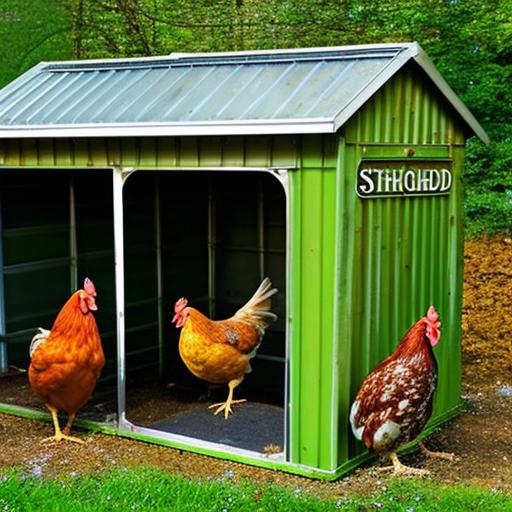Keeping chickens has become a popular hobby for many people, as it provides fresh eggs and entertainment for the whole family. When it comes to housing chickens, there are various options available, and one of them is using a metal shed. Metal sheds can be a cost-effective and durable choice for chicken keeping. In this blog post, we will explore the pros and cons of using a metal shed for chicken keeping, factors to consider before getting started, and tips for designing and maintaining a metal shed for your feathered friends.
Key Takeaways
- Metal sheds can be used for keeping chickens, but certain factors need to be considered.
- Pros of using a metal shed include durability and ease of cleaning, while cons include temperature regulation and potential for rust.
- Factors to consider before keeping chickens in a metal shed include size, location, and predator protection.
- Design considerations for a metal shed include ventilation, lighting, and nesting boxes.
- Preparing a metal shed for chicken habitation involves cleaning and disinfecting the space.
- Certain breeds of chickens, such as bantams, are better suited for smaller metal sheds.
- Feeding and watering chickens in a metal shed requires proper placement of feeders and waterers.
- Maintaining hygiene in a metal shed involves regular cleaning and disinfecting of the space and equipment.
- Temperature and ventilation considerations include insulation and proper air flow.
- Overall, a metal shed can be suitable for keeping chickens with proper planning and maintenance.
Pros and cons of using a metal shed for chicken keeping
There are several advantages to using a metal shed for housing chickens. Firstly, metal sheds are affordable and easy to assemble. They can be purchased at a reasonable price and can be put together with minimal effort. Secondly, metal sheds provide good protection from predators. The sturdy construction of a metal shed makes it difficult for predators such as raccoons or foxes to break in and harm your chickens.
However, there are also some drawbacks to using a metal shed for chicken keeping. One of the main concerns is the temperature inside the shed. Metal sheds can get hot in the summer and cold in the winter, which can be uncomfortable for the chickens. Additional insulation or ventilation may be required to regulate the temperature inside the shed. Another consideration is that metal sheds may not provide as much natural light as other types of housing, so it is important to ensure that there is enough light for the chickens.
Factors to consider before keeping chickens in a metal shed
Before deciding to keep chickens in a metal shed, there are several factors that need to be considered. The first factor is the location of the shed. It is important to choose a spot that is level, well-drained, and away from any potential hazards such as trees or power lines. The location should also provide easy access for cleaning and maintenance.
The size of the shed is another important factor to consider. Make sure that the shed is large enough to comfortably house your chickens and provide room for nesting boxes, perches, and feeders. The chickens should have enough space to move around and stretch their wings.
Climate is also an important consideration. Different climates require different measures to ensure the comfort and well-being of the chickens. For example, in colder climates, insulation and heating may be necessary to keep the chickens warm during the winter months. In hotter climates, proper ventilation and shade should be provided to prevent overheating.
Designing a metal shed for chicken keeping
When designing a metal shed for chicken keeping, there are several things to consider. Firstly, choose a shed with windows or vents to provide natural light and ventilation. This will help regulate the temperature inside the shed and provide fresh air for the chickens.
Next, install nesting boxes, perches, and feeders to create a comfortable and functional living space for your chickens. Nesting boxes should be placed in a quiet and secluded area of the shed to provide privacy for the hens when they lay their eggs. Perches should be placed at different heights to accommodate the different sizes of chickens.
Consider adding insulation or a heating source for colder climates. Insulation can help keep the shed warm during the winter months, while a heating source such as a heat lamp or heated pad can provide additional warmth when needed.
Preparing the metal shed for chicken habitation
Before introducing chickens to the metal shed, it is important to prepare it properly. Start by cleaning the shed thoroughly and removing any debris or potential hazards. This will help create a clean and safe environment for the chickens.
Next, install a sturdy floor covering such as linoleum or rubber mats. This will make cleaning easier and prevent moisture from seeping into the floor. It will also help protect the chickens’ feet from injury.
Finally, add bedding material such as straw or wood shavings to create a comfortable and absorbent surface for the chickens. The bedding should be changed regularly to maintain cleanliness and prevent odors.
Choosing the right breed of chickens for a metal shed

When choosing chickens for a metal shed, it is important to consider the size and temperament of different breeds. Some breeds are more suited to living in confined spaces, while others require more room to roam. It is also important to consider the egg-laying abilities of the breed, as well as their tolerance to cold weather.
Some good options for metal shed living include Rhode Island Reds, Plymouth Rocks, and Leghorns. These breeds are known for their hardiness, adaptability, and good egg production.
Feeding and watering chickens in a metal shed
Proper feeding and watering are essential for the health and well-being of your chickens. Provide fresh water and food daily, and make sure your chickens have access to grit and oyster shells for digestion.
Consider using a hanging feeder or waterer to save space and prevent spills. These can be easily hung from the ceiling or walls of the shed, keeping the food and water off the ground and reducing the risk of contamination.
Maintaining hygiene in a metal shed for chicken keeping
Maintaining proper hygiene in the metal shed is crucial for the health of your chickens. Clean the shed regularly, removing any soiled bedding or debris. This will help prevent the buildup of bacteria and disease.
Use a disinfectant spray to kill bacteria and prevent disease. Make sure to follow the instructions on the disinfectant product and use it in a well-ventilated area.
Consider using a deep litter method, where fresh bedding is added on top of old bedding. This creates a composting effect that can help control odors and pests. The old bedding will break down over time, providing a natural source of heat and insulation for the chickens.
Temperature and ventilation considerations for a metal shed
Temperature and ventilation are important considerations when keeping chickens in a metal shed. Install windows or vents to provide natural ventilation and allow fresh air to circulate. This will help regulate the temperature inside the shed and prevent the buildup of moisture and odors.
Consider adding insulation or a heating source for colder climates. Insulation can help keep the shed warm during the winter months, while a heating source such as a heat lamp or heated pad can provide additional warmth when needed. Use a thermometer to monitor the temperature inside the shed and make adjustments as needed.
Is a metal shed suitable for keeping chickens?
In conclusion, using a metal shed for chicken keeping has its pros and cons. While there are some challenges to overcome, with proper planning and maintenance, it can be a great option for backyard chicken enthusiasts.
Consider the pros and cons, and make sure to take into account factors like location, climate, and breed selection before getting started. With the right design, preparation, and care, your metal shed can provide a safe and comfortable home for your feathered friends.
If you’re considering keeping chickens in a metal shed, you may want to check out this informative article on Poultry Wizard’s website. They provide valuable insights on various aspects of chicken keeping, including tips on building a chicken coop in Grand Island, NE. This article offers practical advice and step-by-step instructions for creating a safe and comfortable environment for your feathered friends. Whether you’re looking for chicken coop run plans or guidance on how to insulate a chicken coop, Poultry Wizard has got you covered. Explore their website to discover more helpful resources for successful chicken keeping. (source)
FAQs
Can you keep chickens in a metal shed?
Yes, you can keep chickens in a metal shed. However, there are certain factors to consider before doing so.
What are the factors to consider when keeping chickens in a metal shed?
The factors to consider when keeping chickens in a metal shed include ventilation, insulation, lighting, and space. The shed should have proper ventilation to prevent the buildup of ammonia and other harmful gases. It should also be insulated to keep the chickens warm during cold weather. Lighting is important for the chickens’ health and egg production. Lastly, the shed should have enough space for the chickens to move around and exercise.
What type of metal shed is best for keeping chickens?
The best type of metal shed for keeping chickens is one that is sturdy, well-ventilated, and insulated. It should also have windows or skylights to provide natural light and fresh air.
How many chickens can you keep in a metal shed?
The number of chickens you can keep in a metal shed depends on the size of the shed. As a general rule, each chicken needs at least 4 square feet of space. Therefore, a 10×10 foot shed can comfortably house up to 25 chickens.
What should you put on the floor of a metal shed for chickens?
The floor of a metal shed for chickens should be covered with a layer of bedding material such as straw, wood shavings, or sand. This will absorb moisture and droppings, and provide a comfortable surface for the chickens to walk on.
What should you feed chickens kept in a metal shed?
Chickens kept in a metal shed should be fed a balanced diet of chicken feed, which can be supplemented with fresh fruits and vegetables. They should also have access to clean water at all times.
Meet Walter, the feathered-friend fanatic of Florida! Nestled in the sunshine state, Walter struts through life with his feathered companions, clucking his way to happiness. With a coop that’s fancier than a five-star hotel, he’s the Don Juan of the chicken world. When he’s not teaching his hens to do the cha-cha, you’ll find him in a heated debate with his prized rooster, Sir Clucks-a-Lot. Walter’s poultry passion is no yolk; he’s the sunny-side-up guy you never knew you needed in your flock of friends!







